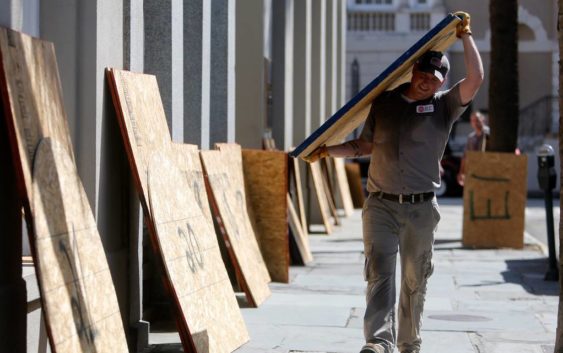- Houston Cougars take on A&M Aggies in charity exhibition game supporting Hurricane Beryl relief
- Hurricane Helene donations delivered to Avery County for Share the Warmth campaign
- Old Crow Medicine Show founder talks music, hurricane relief and this weekend's big benefit show
- IV fluid shortage caused by hurricane to last for months
- 'It financially annihilated us': Pregnant mother displaced for 2nd time after western NC floods
Trump’s tariffs will make recovery from Hurricane Florence more expensive

The tariffs President Trump has slapped on imports from China, Canada and other countries — as well as new tariffs he is expected to announce late Monday — are almost certain to make it more expensive for homeowners in the Carolinas to rebuild and refurnish after Hurricane Florence.
While prices naturally rise after a natural disaster, given the spike in demand for building materials, Trump’s trade war has already boosted costs for imported plywood and lumber, which jumped 30 percent in the six months after the Trump administration announced tariffs on Canadian softwood timber in December.
In addition, Trump’s tariffs on Chinese imports have raised prices for furniture, washing machines and other appliances, and the administration is expected to announce an additional set of duties on $200 billion in Chinese goods as soon as U.S. markets close Monday.
“People should expect to find it will be more expensive to rebuild and refurnish their houses,” said Jock O’Connell, a trade economist affiliated with California-based Beacon Economics. “Whenever there’s a natural disaster, there will be spikes in prices, as demand goes up. This time it will be exacerbated by the impacts of tariffs.”
Homeowners confront an array of challenges rebuilding from the hurricane, including labor shortages and lack of insurance to pay for any rebuilding and losses. But higher costs for building materials and household items will add to those costs, O’Connell and representatives of the building and retail industries say.
Mark Adkison, a vice president for the National Housewares Association, said his trade group is most concerned about the proposed tariffs the Trump administration is expected to soon announce, which could add duties of 10 percent to 25 percent on $200 billion in Chinese goods. The proposed list is broad and sweeping, affecting everything from gypsum used in sheet rock to electronics, textiles and everyday housewares and kitchen gadgets.
“The 25 percent proposal is really concerning,” Adkison said. “It is more than the supply chain can handle, and would result in significant price increases at retail.”
Trump and Commerce Secretary Wilbur Ross have enacted a series of tariffs against top exporters to the United States, including China, Canada, Mexico and the European Union.
The administration says these tariffs are aimed at protecting U.S. farmers, manufacturers and other companies that have been victims of foreign protectionism. But they’ve raised prices for consumers and various U.S. companies, including those that depend on foreign supply chains, and hurt U.S. farmers and other exporters that have been subject to retaliation.
In a series of tweets early Monday, Trump acknowledged his tariffs have caused price hikes, but claimed those cost increases have “thus far been almost unnoticeable” and “put the U.S. in a very strong negotiating position.”
Plywood and drywall are two key building items that could face further price spikes, if the trade war intensifies.
China continues to be the leading supplier of plywood to the United States, despite U.S. tariffs on a range of Chinese wood products last year.
In 2017, U.S. companies imported $1.14 billion in plywood from China, or 41.6% of all plywood imports that year. Through July of this year, imports from China have been down 14.5% from the same period last year, according to O’Connell, citing U.S. Census Bureau trade data.
Some U.S. companies will likely benefit from these tariffs. Weyerhauser, a major landowner and employer in North Carolina, has benefited from higher wood prices, as have other U.S. timber interests. But U.S. building interests have railed against the tariffs.
A study by the National Association of Home Builders estimated that higher lumber costs since 2017, largely because of Trump’s tariffs, have been enough to drive up the price of an average new single-family home by $6,388.
Hurricane Florence potentially could end up damaging 759,000 homes in the Carolinas and other states and cost more than $170 billion in rebuilding costs, according to a pre-storm estimate by CoreLogic, a real estate data firm. While demand for construction materials will soar after the hurricane passes, that demand could be tempered by the fact that many homeowners lack adequate homeowner insurance and federal flood insurance, said O’Connell.
Because of widespread flooding, Florence is likely to spike consumer demand for basic household items, he said. “Furniture, lamps, chairs carpets. All of those will have to be replaced,” he said. “But if you go to Home Depot or Ikea, the price of these things will go shooting up.”